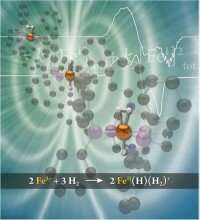Mechanism of iron-based hydrogen bond cleavage revealed

Hydrogen-based fuel cells hold promise for sustainable power generation, but to become practical they need to be more efficient and cost effective. Scientists at Pacific Northwest National Laboratory's (PNNL's) Center for Molecular Electrocatalysis (CME) are working to understand the fundamental reactivity of H2 that could contribute to making hydrogen a more widely used fuel source. Working with a rare iron-based paramagnetic complex, a CME-based research team for the first time reported the mechanism of reactivity of hydrogen and explained in detail how hydrogen atoms are transferred. Their study, "H2 Binding, Splitting, and Net Hydrogen Atom Transfer at a Paramagnetic Iron Complex," appears in the Journal of the American Chemical Society.
Paramagnetic dihydrogen complexes are difficult to study because they cannot be examined using the traditional method of nuclear magnetic resonance spectroscopy. The CME research team combined kinetic, spectroscopic, electrochemical, and computational evidence to reveal that the reaction of the iron complex starts from a single hydrogen molecule (H2) bound to the metal. The subsequent reaction proceeds through an unusual cleavage of the H-H bond of H2 mediated by two iron centers. Metal complexes in which hydrogen (H2) binds to the metal are key intermediates in many catalytic reactions important for energy conversions.
"Only a very few paramagnetic dihydrogen complexes have been reported, and their reactions have not been explored," said Morris Bullock, director of the CME. "This remarkable reaction contributes fundamentally important new understanding to guide the design of new catalysts and electrocatalysts."
More information: Demyan E. Prokopchuk et al. H2 Binding, Splitting, and Net Hydrogen Atom Transfer at a Paramagnetic Iron Complex, Journal of the American Chemical Society (2019). DOI: 10.1021/jacs.8b12823
Journal information: Journal of the American Chemical Society
Provided by Environmental Molecular Sciences Laboratory


















